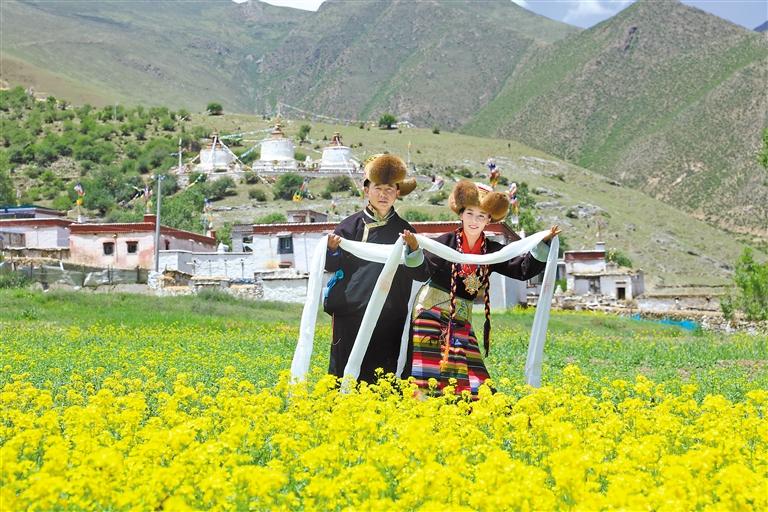
Tourists take photos in Jiama Township, Mozhugongka County.
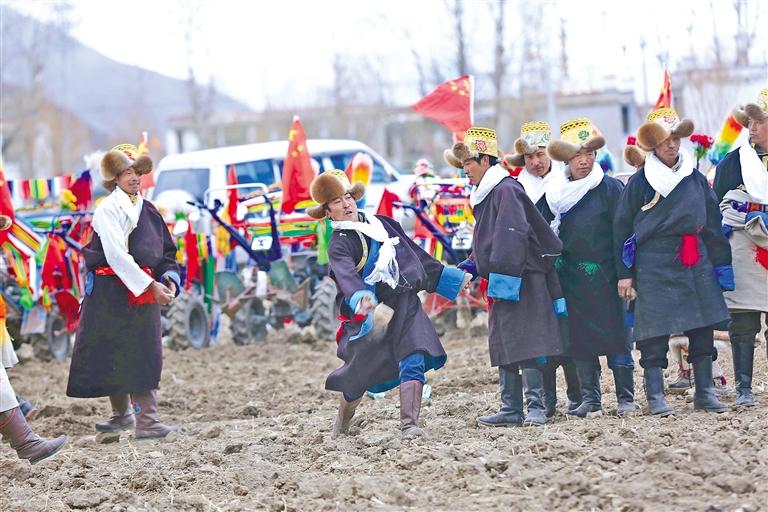
The villagers of Longda Village, Jiama Township, Mozhugongka County carried out the bullhorn activity at the spring plowing ceremony.

The villagers of Zizirong Village, Jiama Township, Mozhugongka County salute highland barley wine at the Tibetan New Year.
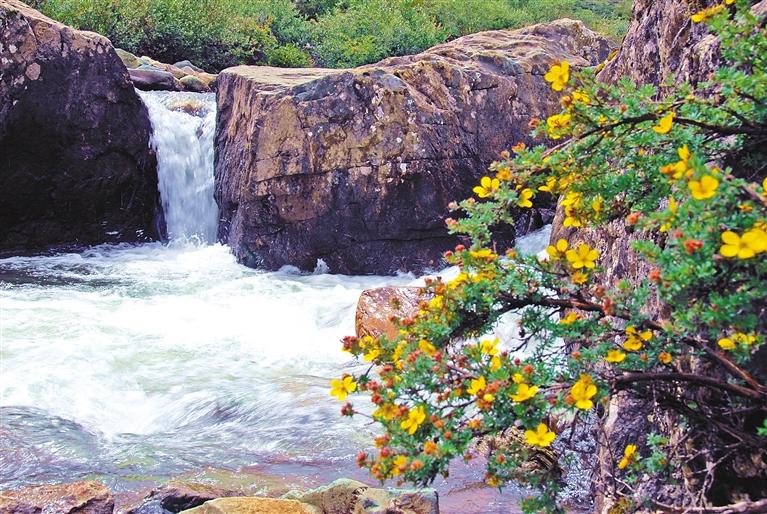
The natural scenery of Jiama Valley in Mozhugongka County.
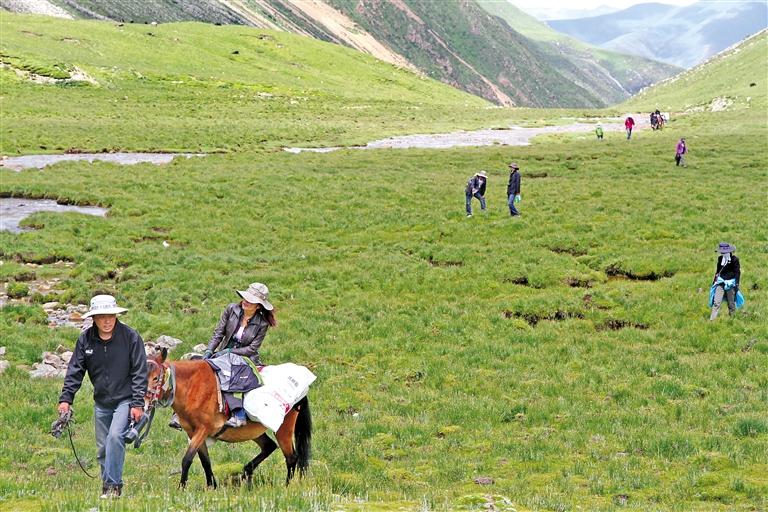
Hiking on Jiasang Ancient Road in Mozhugongka County.
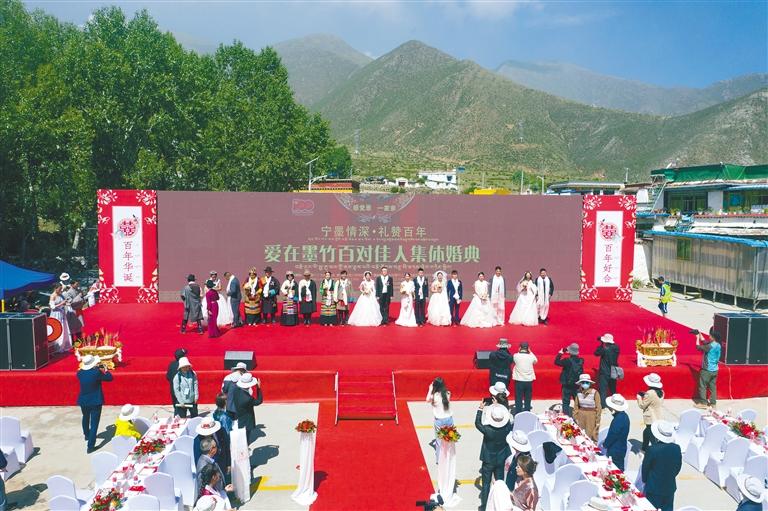
Mozhu Gongka County held the mass wedding ceremony of love in Mozhu for 100 couples.
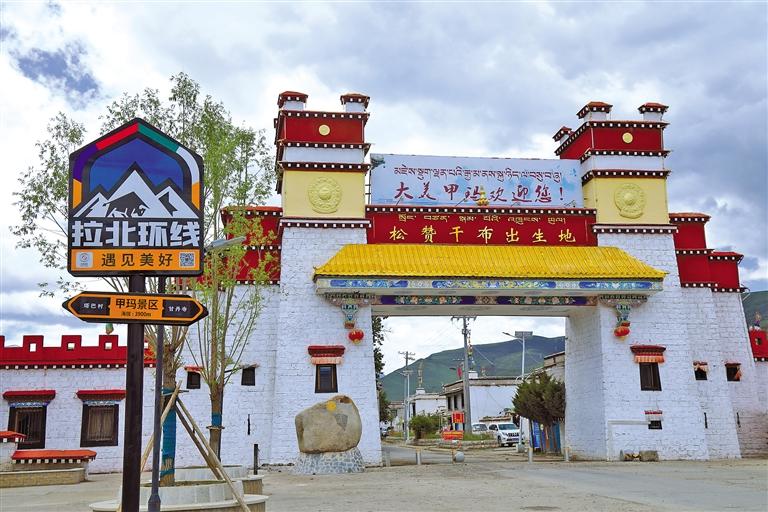
The gate archway of Songzangambu's birthplace in Mozhugongka County.
Driving about 70 kilometers east from Lhasa, you will arrive at Jiamagou in Mozhugongka County. The road to Jiama Village in Jiama Valley is straight and flat, and the vehicles freely shuttle on the road, like the notes beating in the valley.
Jiama, which means "one in a hundred", is a treasure land surrounded by mountains and abundant water and grass. It used to be the "granary" of Tibetan nobles. In midsummer, the blooming rape flowers make the whole mountain valley more dazzling. The golden rape fields and green mountains form a beautiful picture of the countryside, which has also become a popular clocking place for tourists to travel in summer.
Jiama was the activity center for royal ministers to unite, fight and annex in the Tubo Dynasty. In 617 AD, Songtsen Gampo was born here, so Jiama is called "the hometown of Tibetan king". Jiama Valley is the first base camp established by the Tibetan people to cross the Yarlung Zangbo River, occupy the north of the Yangtze River and the Lhasa River basin; In the Yuan Dynasty, it was the "Jiama Wanhu" administration; In the Qing Dynasty, it was the territory of the "Holkang Family" formed by the combination of Mongolian descendants and the Polonai family; Afei Awang Jinmei, a famous figure in modern Tibetan history, grew up here.
In recent years, with the vigorous development of the tourism industry, Jiama Valley relies on the advantage of being close to the national highway, relying on the historical and cultural endowment, rich mineral resources and its own reality of Jiama Valley, vigorously develops the whole region tourism, leads Jiama to speed up the pace of the whole region tourism and rural revitalization, drives the whole township people to become rich without leaving their hometown, and realizes both living in peace and working happily, The ancient village is full of vitality and is welcoming guests from all over the world with its profound cultural heritage.
At the entrance of Jiamagou, there stands a beautiful and huge Tibetan gate pavilion, on which is written "Songzangambu's birthplace". Entering the gate pavilion, the blockhouse style building on the left hillside is the famous Songzangambu Memorial Hall. Tourists can learn about the rise of Yalong tribe, the unification of the plateau, the reform of legislation, the Tang and Tibetan history, and feel the political, economic, and cultural splendor of the Tubo Dynasty in the 7th century.
The whole scenic spot is designed according to the 4A standard, including the Songzan Ganbu Memorial Hall, the ancient city wall, the reconstruction and expansion of Songzan Holy Spring and Songzan Lakang, which integrates tourism, cultural expo and academic exchange.
Holkansa means "the new house of Mongols". Holkang Manor is located in Chikang Village, Jiama Township. During the Yuan Dynasty, Tibet was divided into 13 ten thousand households, and Jiama was one of the 13 ten thousand households. Holkang Manor has a history of more than 800 years, and now covers an area of about 75 mu. It is one of the sixth batch of tourism development projects supported by Nanjing for Tibet. The construction of Holkang Manor not only improves the overall tourism environment of Jiama Scenic Area, but also increases its cultural connotation, providing a more intuitive platform for tourists to understand the history and culture of Tibet. In Holkang Manor Scenic Area, tourists can enrich their personal cultural experience, enjoy the performance of traditional Tibetan opera, and celebrate the Fruit Watching Festival with local people in harvest season to experience local folk customs.
As a kind of singing and dancing performance, "Jiama Xieqin" is called "Chonglu" in the local area. It belongs to a branch of "Xieqin", and was listed in the county-level and municipal intangible cultural heritage projects in 2008 and 2012. In order to better protect and develop the excellent traditional culture, in 2012, Jiama Township established the "Xieqin" Art Troupe. After several years of efforts, in 2014, "Jiamaqieqin" was included in the intangible cultural heritage project at the autonomous region level.
Pubzhuoma, 47, is one of the directors of the "Jiamaqieqin" folk art troupe. During the slack season, she and another person in charge, Pu Budanzhen, would gather the members of the art troupe to rehearse "Jiama Xiechin" on the stage of Holkang Manor. Today, there are more than 20 members of this team, all of whom are local people. The art troupe is often invited to participate in various parties, festival performances, intangible cultural heritage performances, etc., and its influence and communication power are constantly improving.
"In order to protect and inherit this ancient art, the older generation has made great efforts. Today's era is developing rapidly, which also brings opportunities and challenges to the inheritance and development. It provides a good platform for fans to attract more people to participate in the 'Jiamaqieqin'." Pubzhuoma said.
There are several precious stone carvings and rock paintings on display in Holkang Manor, which all come from Jiasang Ancient Road. There is a thousand year old ancient road from Jiama Township to Sangye Temple in Zhabao County, Shannan. According to records, at the end of the 5th century AD, the 32nd generation of Zan Prangri Songzan set out from the Yalong tribe and moved to Jiamagou, opening the Jiasang Ancient Road. Although Jiasang Ancient Road has been unknown for a long time, it is very famous among some hiking enthusiasts. Jiasang Ancient Road not only has pastoral areas and agricultural areas, but also is full of original ecological resources. Along the road, you can watch thousands of years of cliff stone carvings, pass grasslands, lakes, snow mountains, primitive forests and other natural features, and also explore, photograph, collect wind, etc.
Jiama Township has three villages, namely Longda Village, Chikang Village and Zizirong Village. Standing at the Songzangambu Memorial Hall, you can see Zizirong Village. Neat and flat roads connecting villages and villages are winding along the hillside terrain, and rows of new and neat Tibetan houses are well arranged. The well-off and comfortable housing project in Zizi Rong Village was designed into a "mushroom cloud" shape by specially hired experts, which looks like colorful "auspicious clouds" from afar. The lush willow trees make this "auspicious cloud" very fresh and beautiful.
In recent years, the number of restaurants, shops and supermarkets on the street has increased rapidly, and the development of the whole gully is thriving. This is because Jiama Township highlights the integration of industry and city development, coordinates the construction of infrastructure and modern service industry, focuses on the development suitable for business and living, and creates a new characteristic small town with convenient travel, beautiful environment and complete supporting facilities. "Jiama Township is implementing a global tourism strategy, and the beautiful scenery in the ravines is a new business card of 'staying green mountains and rivers, remembering nostalgia'," said Deji Zhuoga, a staff member of Jiama Township.
In the future, Jiama Township will continue to cooperate with the superior departments to build an overall tourism industry in Jiama Township, further enrich tourism carriers and the economy of Linka, such as the gate of the scenic spot, Holkang Manor, Songzangambu Memorial Hall, Chikang Village Party Building Park, homestays, and Linka, vigorously build a cultural and tourism town, cultivate the brand of "Songzan Hometown", and carry out patriotism education, Create a variety of cultural, tourism and leisure businesses, improve tourism supporting services, and strive to write a "new chapter" of global tourism. Tibet Daily correspondent Luo Kedeji Zhuoga Tibet Daily reporter Pei Congge Sang Lunzhu















